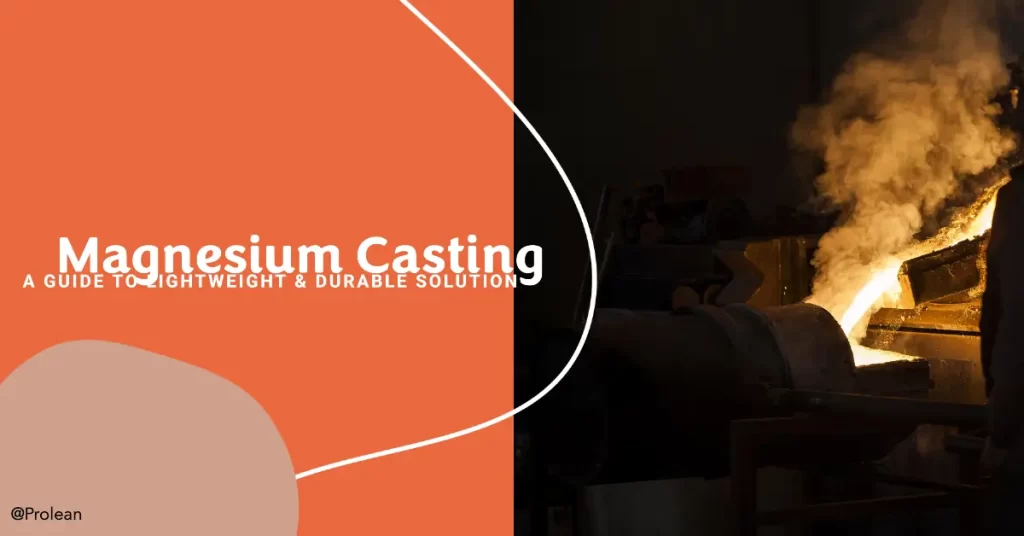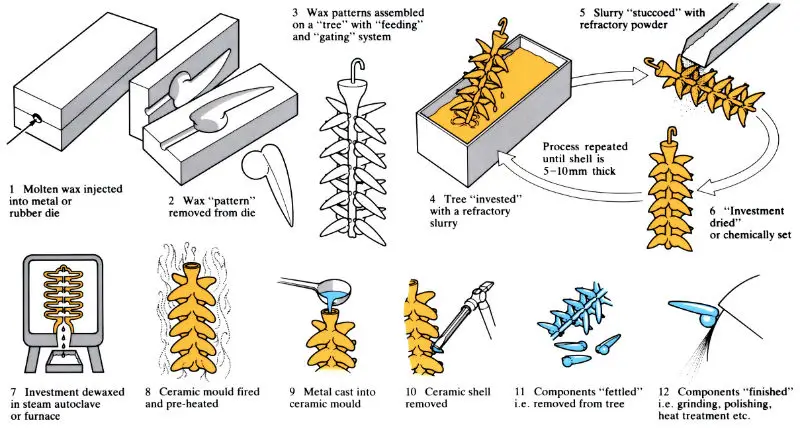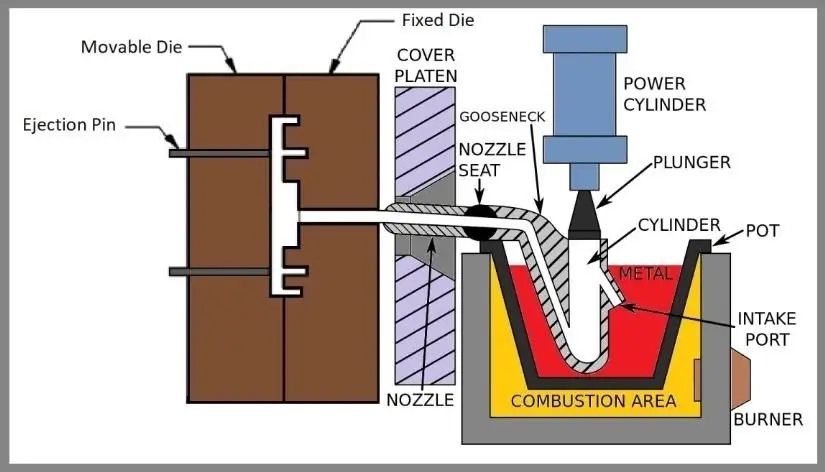
Magnesium casting is the method of making metal components using molten magnesium and magnesium alloys. Magnesium casting makes the lightest, strongest, and most durable metal parts. It is well known for its adaptability. This method gives businesses efficient solutions that boost quality and save weight. The lightweight components are used in airplanes, automobiles, and electronics. This article will explain magnesium casting, how it works, and why companies use it.
What is Magnesium Casting?
Magnesium casting is a mold-making procedure. It involves melting magnesium alloys and pouring the molten material into a mold to create the desired shape. Magnesium’s low weight and high strength make it very useful. This process is widely used in electronics, aircraft, and auto industries.
Magnesium is only viable in conditions with a high pH, and it corrodes easily in surroundings with a low pH, which restricts its use in practical settings. Magnesium alloys, which are formed by combining magnesium with other metals, are strong and resistant to corrosion.
Try Prolean Now!
Advantages of Magnesium Casting Alloys
In comparison to numerous other alloys, magnesium is the lightest structural metal available. Magnesium Casting alloys have the following advantages:
- Lighter than titanium by 50% and steel by 75%
- One-third as light as aluminum
- Extremely advantageous for recycling
- Excellent surface finishes
The combination of these qualities makes magnesium an excellent material for prototypes and lightweight components.

Magnesium die casting alloy
Magnesium Casting Methods
The industrial sector makes use of a wide range of magnesium casting processes. Recent advances in magnesium molding techniques have improved production speed. They also enhanced surface polishing, reduced void visibility, and enabled complex geometry. Magnesium casting has many distinct methods. Each has unique advantages for various uses.
Several casting methods are available, such as:
- Magnesium Die casting (high-pressure and low-pressure)
- sand casting (green sand and resin sand)
- investment casting
- permanent mold casting
- hot chamber casting
- cold chamber casting
A particular method is chosen based on several criteria. This includes production volume, item complexity, and required surface polish.
Types of Magnesium Casting Processes
There are many types of casting processes for magnesium casting, a hot or cold chamber, and both work well with magnesium alloys.
Sand Casting
Parts made of cast metal using sand molds are called sand castings. The sand, which is combined with a binder is molded into the required shape using two match plates in this process. The “die” used in casting is really the two sides of the sand mold. Metal casting is made by pouring molten metal into a sand die.

Sand casting process
Investment Casting
A wax design is made and coated with ceramic. Then, the wax is melted away to form a hollow mold. This technique is sometimes called lost-wax casting. Parts with intricate details are created by pouring molten metal into this mold. It is perfect for complex forms and produces high-quality surface finishes.

Process of investment casting
Permanent Mold Casting
Parts are cast using a reusable metal mold, sometimes called a die. The mold is filled with molten metal and let to cool and harden. The mold may be reused. So, this procedure is good for medium to large volumes. It is often used for metals like magnesium and aluminum. It produces smooth surfaces and high precision.
Hot Chamber Die Casting
This technique combines the oven and casting machine. It shortens manufacturing cycles. It is also called “gooseneck” casting. To minimize oxide inclusions and air exposure, the molten metal is pushed into the mold using a heated gooseneck system. It works well with magnesium and other metals with a lower point of melting. Due to the additional maintenance demands caused by constant high temperatures, hot chamber die casting is more expensive, even if the cycles are shorter.

Parts of a hot-chamber casting machine
Cold Chamber Die Casting
The procedure involves moving the molten metal from one furnace to another, cooling it in an unheated room, and then injecting it into the mold under pressure. Metals such as magnesium, aluminum, and copper have higher melting points and are perfect candidates for this process. Gas setup may degrade quality and lengthen cycle times, but it’s cheaper and requires less maintenance. Due to its high melting point, magnesium is best cast using cold chamber die casting rather than expensive integrated machinery.
Try Prolean Now!
Magnesium Die Casting: A Method in Magnesium Casting
In magnesium die casting, molten magnesium (or magnesium alloy) is injected into a mold to make shapes. Magnesium alloy is a blend of magnesium and other metals. The process involves melting the alloy in a die casting machine. The molten material is subsequently poured into the mold and solidifies or is pressed into it by a hydraulic press (pressure die casting). After the molten material solidifies, the mold opens. Then, the part is removed, either automatically or manually.
Magnesium Die Casting Process
Magnesium die-casting requires a cool chamber to prevent machine damage due to magnesium’s high melting point. The process is executed under close supervision. The magnesium casting process that turns raw magnesium into a finished product is given below:
Alloy Preparation
First, we make better magnesium alloys by mixing magnesium with other elements, like zinc, aluminum, or others. The metal alloys are first heated to a molten state in a furnace.
Melting and Dispensing
After melting the alloy in a furnace, carefully pour it into a mold that has already been built. This mold’s material could be sand, metal, or something else. The next step involves pouring the molten magnesium into a die cavity via a shot cylinder.
Consolidation
A faster rate of molten magnesium entry into the die cavity is achieved by the use of the piston. Then it is allowed to cool and solidify for a while. The machine then ejects it after it has cooled.
Trimming
Magnesium, once poured, cools and solidifies into the form you choose. The part is taken out of the mold and prepared for further processing after it has cooled.
Trimming or machining removes the surplus metal from the casting. Therefore, for the highest quality metal cast components, the magnesium die-casting method is used.
Finishing Details
Extra steps may be needed to improve the product’s surface, add coatings, or remove excess material. Before shipment, quality inspections guarantee that the component satisfies all requirements.
Popular Magnesium Casting Alloys
Magnesium alloys often include magnesium, aluminum, silicon, zinc, manganese, and rare earth metals. One way to improve magnesium’s corrosion resistance is to add alloying elements, especially aluminum. Reducing the aluminum content might improve ductility, but it would lower its resistance to corrosion.
Several magnesium alloys may be used for various purposes. AM50A, AM20, AM60B, AS41B, and AE42 are typical examples. Die casting companies use AM50A, AM20, and AM60B for toughness, ductility, and impact resistance. The use of AS41B and AE42 for projects needing ductility, creep resistance, and high-temperature strength.
Alloys made of magnesium and other metals have several advantages over their components. The following magnesium alloys are among the most popular for use in casting:
AZ91D
The most popular is the magnesium die casting alloy AZ91D, which has zinc and aluminum. An alloy’s 9% aluminum and 1% zinc improve its properties. It has better mechanical strength, corrosion resistance, and castability. Automotive and electrical parts often use it.
AM60B
This alloy is a popular choice for structural uses. It has high ductility and impact resistance.
Zebra 60
Aerospace components often use ZK60. It has a high strength-to-weight ratio. This is crucial for performance-oriented applications. Each magnesium alloy has unique advantages. So, choosing the right one is an art.
Magnesium Die Casting companies
Magnesium die casting might be your best choice for high-quality, reliable parts. The best way to get additional information on this is to seek out die magnesium casting companies. It is vital to find a reputable company that can fulfill your requirements for quality, affordability, and timeframe demands.
Looking for high-quality magnesium die casting? Contact us for die casting services. Since we’re experts, our products are high-quality, durable, and inexpensive. Get in touch with us now to explore how magnesium die casting might help your project or organization.
Try Prolean Now!
Final Thought
Magnesium casting is an inexpensive and flexible method. It makes lightweight, durable, high-quality products for many uses. This technique is used in consumer gadgets, automobiles, and aerospace industries. Knowing the magnesium die casting process and its alloys may help. It could help you choose the right one for your next project.
Magnesium alloys provide exceptional energy efficiency and efficacy, regardless of whether they are produced through investment casting or die casting. Selecting a reputable die casting service helps ensure reliable and flawless magnesium die casting.




0 Comments